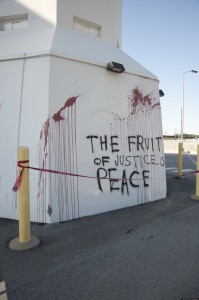 A Reporter at Large, March 9, 2015 Issue of the New Yorker
A Reporter at Large, March 9, 2015 Issue of the New Yorker
by Eric Schlosser
The Y-12 National Security Complex sits in a narrow valley, surrounded by wooded hills, in the city of Oak Ridge, Tennessee. Y-12 and Oak Ridge were built secretly, within about two years, as part of the Manhattan Project, and their existence wasn’t publicly acknowledged until the end of the Second World War. By then, the secret city had a population of seventy-five thousand. Few of its residents had been allowed to know what was being done at the military site, which included one of the largest buildings in the world. Y-12 processed the uranium used in Little Boy, the atomic bomb that destroyed Hiroshima. Seven decades later, Y-12 is the only industrial complex in the United States devoted to the fabrication and storage of weapons-grade uranium. Every nuclear warhead and bomb in the American arsenal contains uranium from Y-12.
Strict security measures have been adopted at the site to prevent the theft of its special nuclear materials. Y-12 has some five hundred security officers authorized to use lethal force within its Protected Area, five BearCat armored vehicles, Gatling guns that can fire up to fifty rounds per second and shoot down aircraft, video cameras, motion detectors, four perimeter fences, and rows of dragon’s teeth—low, pyramid-shaped blocks of concrete that can rip the axles off approaching vehicles and bring them to a dead stop. The management of Y-12 calls the place “the Fort Knox of Uranium.”
After the terrorist attacks on September 11, 2001, the Highly Enriched Uranium Materials Facility was built, at a cost of more than half a billion dollars, to safeguard Y-12’s uranium. Situated at the north end of the Protected Area, the storage facility is an imposing white structure, longer than a football field, with guard towers at all four corners. If the tops of the towers were crenellated, the building would look like an immense, windowless White Castle. Some nine hundred thousand pounds of weapons-grade uranium are stored inside it. Little Boy—a crude and highly inefficient atomic bomb, designed in the early nineteen-forties with slide rules—contained a hundred and forty-one pounds of weapons-grade uranium, and almost ninety-nine per cent of it harmlessly blew apart as the bomb detonated. Just a couple of pounds underwent nuclear fission—the splitting of atoms—above Hiroshima. And, when that happened, two-thirds of the buildings in the city were destroyed and perhaps eighty thousand civilians were killed. The amount of weapons-grade uranium needed to build a terrorist bomb with a similar explosive force could fit inside a small gym bag.
At about half past two in the morning on July 28, 2012, three people were dropped off at the Scarboro Church of Christ, a modest brick building with a single white spire in an African-American neighborhood of Oak Ridge. They walked through the church parking lot to a nearby dirt path, followed the path through a stand of trees, reached a meadow, and turned left. Up ahead, in the darkness, they could see the silhouette of a steep hill called Pine Ridge. On the other side of the hill was Y-12. All three had spent time in federal prison. They belonged to a loosely organized group whose members have been prosecuted by the Justice Department for violent crimes, sabotage, and threatening the national security. The three hoped to reach the uranium-storage facility before sunrise, having carefully planned the intrusion for more than a year. But they had no desire to steal anything or to make a bomb. They wanted to “heal” and “transform” the building with their own blood; to mark it as a symbol of evil, empire, and war; to protest against its role in maintaining America’s nuclear arsenal. Gregory Boertje-Obed was a Christian pacifist in his late fifties who painted houses for a living and worked with the homeless in Duluth, Minnesota. Michael Walli was a Catholic layman in his early sixties, inspired by the life of St. Francis of Assisi to live humbly and serve the poor. Megan Rice was an eighty-two-year-old nun, a member of the Society of the Holy Child Jesus. Carrying flashlights and backpacks, they headed toward the hill.
Read the rest of the story here.